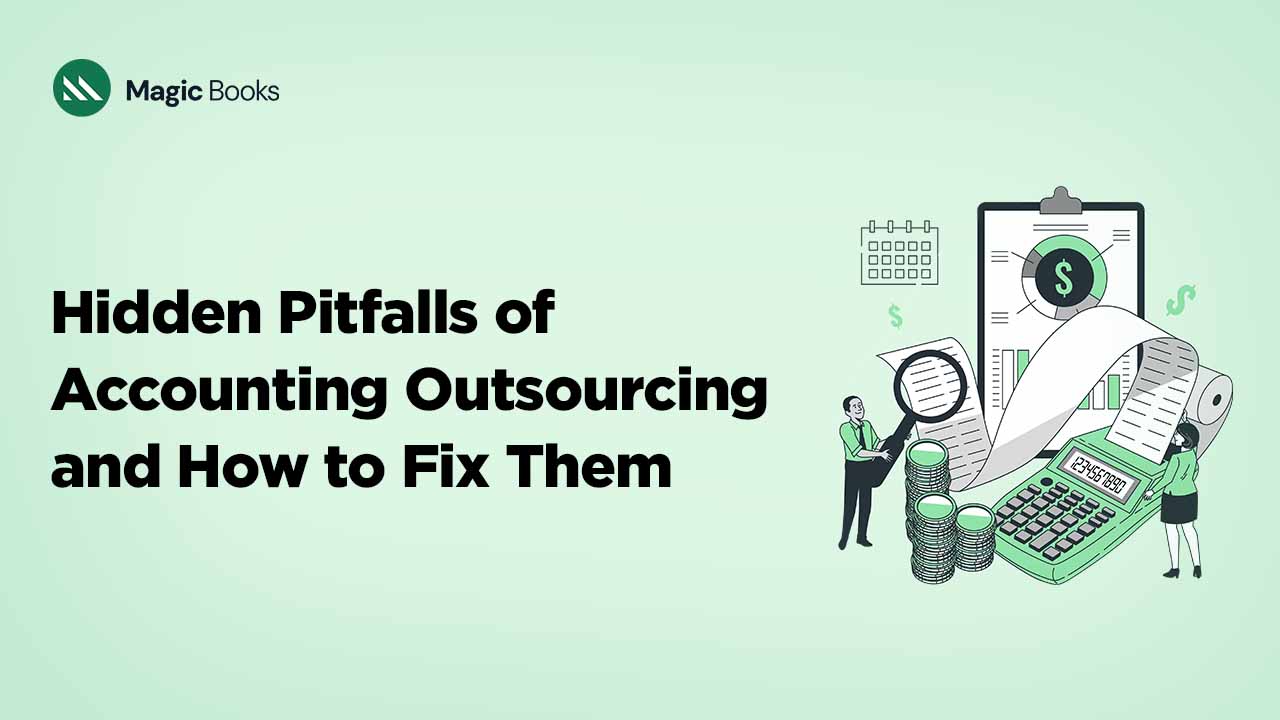Outsourcing accounting functions is a strategic approach for finance firms looking to maximize resources by allowing them to do what is most appropriate – spending time providing high-value advisory services. According to a Capterra 2023 survey, 71% of businesses outsource at least some accounting functions since businesses want to keep their overhead down while using expertise outside their company. This outsourcing trend is driven, in part, by changing regulations – for instance, new revenue-recognition rules under ASC 606 – which make it increasingly difficult for small internal teams to stay knowledgeable in areas outside of their core competencies. Another catalyst for this trend is the dramatic growth of cloud-based bookkeeping platforms that have lowered the barriers to entry for small, organized firms to outsource their accounting functions.
Nonetheless, outsourcing also brings risks. With that said, in this post, we will further explore four of the most common challenges – Data Security and Confidentiality, Communication and timeliness, Quality Control and Accuracy, and Scaling for Growth and Flexibility – and learn some proven ways to overcome them. Drawing on industry statistics and GPS-based practice frameworks, you’ll have tools available to create a review process for vendors’ selections, contracting, and pricing models that will provide you with peace of mind and compliance, lower error rates, and better ROI.
Challenge 1 – Data Security and Confidentiality
Outsourcing accounting services always entails the sharing of sensitive financial and personal information—payroll data, tax returns, bank statements—subject to laws like GLBA (Gramm-Leach-Bliley Act), SOX (Sarbanes–Oxley Act), and SEC reporting regulations. A single lapse can fetch astronomical penalties, class-action lawsuits, and long-term reputational losses. Indeed, one in three firms experiences data breaches of over $1 million during the previous three years. When client confidence and regulatory compliance depend on unbreachable data protection, even a single misstep in a single security process can undo the operational efficiencies of outsourcing.
In addition, third-party vulnerabilities are now a major cyber threat. PwC’s 2025 Digital Trust Insights Survey says that 48% of the participants mention third-party breaches—where cybercriminals exploit vulnerabilities in suppliers or subcontractors—as their main concern. With several service providers, including fourth-party subcontractors, being brought onboard by organizations, the attack surface grows exponentially. Without an official Third-Party Risk Management (TPRM) program, most organizations lack sufficient visibility into the security posture of their supply chain, thus leaving them open to cascading failure.
A cautionary real-world case study is offered by accounting firm B&K, which was sued after a breach that revealed the unencrypted personal information of more than 270,000 individuals, including Social Security and passport numbers. It took the firm almost a year to inform regulators and impacted clients, thus multiplying both legal and reputational fallout. Similarly, a vignette in the Journal of Accountancy describes the case of an employee who copied unencrypted payroll information onto a flash drive, which she then went on to lose, which forced the firm into crisis management mode at warp speed, including mandatory breach and client notification.
Typical weaknesses in outsourced activities include unencrypted data transmission, inadequate access controls, and inadequate incident-response planning. Best-of-breed providers encrypt data in transit and storage using AES-256, use multi-factor authentication (MFA), and conduct regular, third-party security scans to detect and remediate vulnerabilities. They also enshrine 24-hour breach notice provisions and strong non-disclosure agreements (NDAs) to guarantee that any breach triggers immediate containment and open communication. By being aware of these risk factors and demanding stringent mitigation, banks and other financial institutions can protect client data and maintain the trust that is so crucial to their business.
Proven Strategy 1 – Rigid Vendor Vetting
To protect confidentiality, you will need a thorough vetting procedure with multiple steps:
- Assessment of Certifications: Require documentation of SOC 2 Type II (controls over time) and ISO 27001 (information-security management) certifications to ensure that any providers are regularly audited by an independent third party.
- Review of Compliance History: Review any incidents or breaches occurring in the past. Ask for redacted client incident-response reports along with their remediation time frames.
- Assessment of Technical Safeguards: Verify whether their product requires end-to-end encryption (both “in transit” and “at rest”), MFA, and network segmentation.
The top 3 Security Standards to review include the following:
- SOC 2 Type II Reporting Period Integrity
- ISO 27001 Certified Information Security Management
- AES-256 Encryption At Rest and TLS 1.2+ In Transit
Consider including a clause stipulating a 24-hour breach disclosure, and clear instructions around data-destroy/return protocols upon expiration of the contract.
Challenge 2 – Communication and Responsiveness
Outsourced accounting staff tend to cut corners across geographies, creating time-zone gaps, language subtleties, and conflicting workflows that interrupt timely collaboration. When a U.S. company’s close-of-month inquiries fail to get responses overnight, cascading delays on the next business day follow—delayed reconciliations, halted payroll runs, and irate internal staff. Time-zone differences and language gaps are among the leading causes of miscommunication, the Association of Accounting Technicians reports, slowing the resolution of tasks and raising the risk of expensive errors. Without defined procedures, routine clarifications (e.g., a chart-of-accounts question) can extend from hours to days, undermining the efficiency value of outsourcing.
In addition, poor responsiveness directly undermines productivity. In a study by LiveWell Finance, asynchronous hand-offs—when one team completes their day just as another is starting—can add an average of 1–2 full business days to month-end close cycles unless overlapping hours or well-defined escalation paths are established. In one such instance, a California advisory firm outsourced its bookkeeping operation offshore but failed to implement a common “core hours” window; as a result, daily bank reconciliations consistently ran behind, causing onshore staff to waste time obtaining updates.
Overall, the bottom line was that the firm’s promised 30% time savings evaporated under the strain of constant follow-ups. Finally, undefined processes and fuzzy points of contact amplify risk. Without defined roles, phone-tag replaces problem-solving. An Accounting Insights report identifies that misinterpretation of deliverable specifications—e.g., different formats for financial statements—led to late-fee penalties under IRS rules, accruing at 0.5% a month of past-due tax payments. Likewise, in the absence of a liaison or SLA-supported response time, frequently urgent issues escalate without resolution, eroding client confidence and exposing firms to compliance gaps.
Proven Strategy 2 – Define SLAs and Check-In Cadence
In order to maximize responsiveness:
- Define SLAs: Create formal documentation of deliverables (e.g., weekly bank reconciliations and monthly financials) along with explicit timeline due dates, and established responses (e.g., 4 business hours maximum for urgent questions; 24 hours for regular queries).
- Escalation Paths: Identify your primary, secondary, and executive contacts, and the timeline for any unresolved issues.
Regular Check-Ins:
- Status Calls – Weekly to review operational status.
- Performance Reviews – Monthly review of KPI’s (e.g., on-time delivery rate, and query time to resolve).
- Executive Reviews – Quarterly assessment of strategic alignment.
Also, build performance action items for both providers (e.g., a bonus for hitting 99% SLA) and penalties (e.g., fee reductions for missing deadlines) to align provider actions with your firm’s priorities.
Challenge 3 – Quality Control and Accuracy
Accounting errors, both internally and externally derived, have enormous financial, regulatory, and reputational costs. In a groundbreaking report of 50 live spreadsheets, researchers found that error rates ranged from 0.8% to 1.8% of all formula cells, with a number of errors leading to material misstatements and multi-million-dollar losses. For outsourced engagements, such risks can be compounded by non-standard methods, differences in employees’ competence, and poor control.
Manual Processes, as of a 2025 Exela F&A Solutions finance function study, have an average error rate of 4%, and each defect takes $53–$125 in rework. For a mid-market business processing 60,000 transactions per year, this translates to $127,200–$300,000 in pure waste—materials that are steered away from value-added work.
Key restatements and anecdotes:
Large companies have experienced spectacular failures because of lapses in quality. In late 2023, Macy’s discovered $151 million in bogus bookkeeping entries over two years, pushing the release of quarterly results and prompting investor outcry. At the “ground level,” a U.S. accounting staff reported being forced to reconcile more than 1,000 duplicate bank transactions following outsourcing to an offshore provider—an exercise in rework far more than the provider’s $750 “make-good” proposal.
Common Vulnerabilities:
- Chart-of-Accounts Misalignment: Providers unfamiliar with your custom account structures often misclassify expenses, leading to misstatements.
- Training Gaps: Offshore employees may lack domain knowledge in U.S. GAAP nuances or industry practices, increasing the risk of mistakes.
- Manual Dependency: Overdependence on manual entry of data promotes typographical and transcription errors, especially under close deadlines. Medius, a top AP-automation provider, cautions that misclassifications of charges and inadequate reconciliation controls are two of the most prevalent root causes of errors in outsourced accounting.
Regulatory and Financial Impacts:
Even small mistakes can snowball into massive penalties. The Internal Revenue Service (IRS) imposes a penalty of 0.5% of the amount of tax owed for each month the mistake is not corrected, with daily compounding to a maximum of 25%, before interest charges. In addition, misstatements can render tax-filing extensions irrelevant, trigger underpayment penalties, and draw audit attention, all of which take time and money.
Quality-Control Best Practices:
To protect against such weaknesses, high-quality outsourced accounting firms utilize multi-step audit procedures:
- Independent Confirmation by Experienced Professionals: A capable manager or partner confirms samples of significant transactions prior to reporting.
- Comprehensive Audit Trails: Time and comments are stamped on journal entries and reconciliations, providing transparency in review and external auditing.
Standardized Approval Workflows feature automated “check-and-balance” processes that guide entries through pre-defined gates, thereby minimizing dependence on manual sign-offs.
FinOps Partners observe that such models can reduce error rates by up to 70%, and with that, cost savings directly as well as increased stakeholder confidence
Proven Strategy 3 – Having a Strong Review Process
Use a three-layered review approach:
- Periodic Audits: Hire an internal or independent auditor each quarter to sample transactions, check off from your chart of accounts, and check reconciliations.
- Peer Reviews: Have a second employee accountant check their work through and cross-check journal entries and notes on exceptions, in order to instill accountability.
- Month-End reconciliation sweep: Take balances in a given subledger and compare it to the balance in the general ledger; rely on automated reconciliation to point to discrepancies.
Use common checklists and software for workflow (e.g., approval gates in your ERP) to record sign-offs and to record how to resolve exceptions. Layers of the review process have a much reduced error rate, along with an audit trail for compliance.
Outsourcing or sharing accounting functions offers tremendous advantages—saving money, specialized expertise, and the ability to focus on providing strategic advice. However, business owners must think through four principal challenges—we will address these challenges: Data Security and Confidentiality, Communication and Responsiveness, Quality Control and Accuracy, and Scaling for Growth and Flexibility.
With these four strategies—thorough vendor due diligence, explicit SLAs with regular check-ins, a highly defined multi-tiered review procedure, and tailored, performance-based pricing models—you will reduce risk and establish your firm for long-term success.



